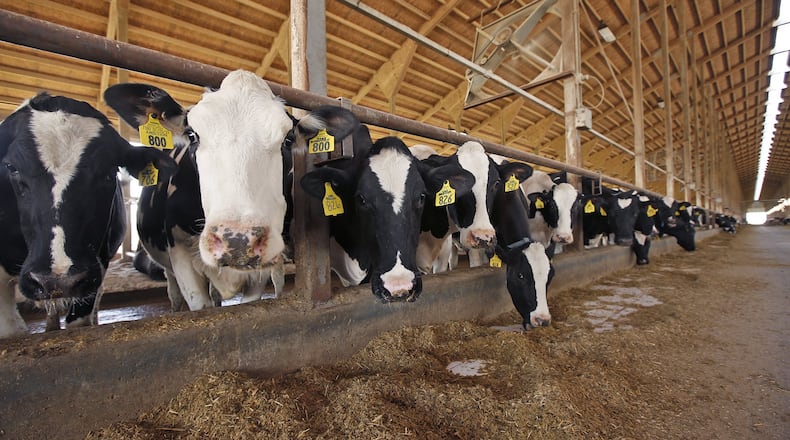Local extension educators said over the last five years dairy farms are down more than 20 percent in Mercer County and 25 percent in Darke County — two of the largest milk producing counties in the state.
Many dairy farmers, especially small ones, haven’t been able to weather the storm in a four-year milk price slump that has favored consumers. Prices farmers receive now are at some of the lowest in the last half a century when adjusted for inflation.
In December, farmers received $15.70 per hundredweight for their milk compared to $20.20 in December 2014, according to the U.S. Department of Agriculture.
RELATED: JCPenney plans more store closures amid sales slump
A gallon of milk costs an average $2.91 today, compared to $3.76 in January 2015, according to the Bureau of Labor Statistics. This is the longest downturn for milk prices Shoemaker said she has seen in the 32 years she’s worked in the industry.
“It’s pretty near break even, but it’s four years of not getting good milk prices that hurt,” Fliehman said. “Eventually you can only put band aids on things for so long and then it’s just going to break down and there you have it.”
Fliehman, 45, has started working on an organic farm for eight hours a day. Then he goes home at night to milk his 45 to 50 cows, sleep four to five hours and repeat the next day.
Because of the low price slaughter houses and other farmers are willing to pay for cows right now, Fliehman said he decided to keep his farm open despite previous plans to shut down. By the time he paid taxes and fees when selling his farm, he said he wouldn’t have enough money left over to pay the bills.
“There’s no future in it right now, it’s still not looking good as far as pricing goes,” he said. “I know a lot of dairies are just waiting for cow prices to get up so they can sell out. I mean you can’t afford to stay in it and you can’t afford to get out of it. Everyone’s throwing their hands up saying what are we going to do?”
»RELATED: Victoria’s Secret closing more than 50 stores
The decline in milk prices is a result of both declining demand and increased supply, said Mercer County Ohio State extension educator Denny Riethman. The same number of cows can produce far more milk than in previous years because of improved genetics, better nutrition and extra care as farmers increase efficiency.
The country also exports a significant amount of milk and imports steel to be used in equipment, which has been impacted by tariffs, Riethman said.
Ohio is subject to these national trends, but also is hit harder by a changing relationship between farmers and processors, Shoemaker said. Since Ohio farmers have traditionally not produced as much milk as processors in the state can handle, those processors began offering incentives for more quality milk from Ohio farmers to limit the amount they had to pay to be transported from other states, Shoemaker said.
But then Michigan farmers ramped up milk production over the last several years and didn’t have the processing capacity within their own state. The farmers now send their milk into Ohio, resulting in a near elimination of the incentives for Ohio farmers.
»RELATED: Booze, bowling and roller coasters: The future for Dayton-area malls
“In the past, when a dairy farmer had a relationship with a processor it was a firm relationship and you didn’t worry about losing your market for your milk at the farm level,” Shoemaker said. “It is not unusual now that a processor — for whatever reason, it might be quality, it might be the farm isn’t shipping enough milk — … will cut farms off and send a letter saying ‘in 30, 60 days, 6 months, we will no longer take your milk.’”
Milk prices have to increase at some point, Shoemaker said, but even once they do, Ohio farmers will still be at a disadvantage because of the changing relationship with processors, though there is a small amount of processing being built in Michigan.
Milk rebounds aren’t something many local farmers and leaders are very optimistic about though. To bring milk prices up, there has to be a decline in cow numbers across the state, several area leaders said. But moving the animals somewhere else doesn’t fix the problem, and few farmers want to send their cows to slaughter, especially with the low prices paid there.
Some progress has been made with 41,000 fewer milk cows in the U.S. today than the same time last year, according to the United States Department of Agriculture.
“I’m not a dairyman, but I can not imagine being tied to the business 24 hours, seven days a week and losing money every single day,” said Sam Custer, extension educator in Darke County.
FIVE FAST READS
• 5 things to know about Payless bankruptcy, sales
•First Wayfair store now permanently open
• Local family growing Rose and Remington store across the U.S.
• Luxury apartments, townhouses, carriage homes coming to Huber Heights
• New owner of Kettering grocery store started as bagger
By the numbers
235,00: Milk cows in Ohio
11: Percent decline in Ohio dairies
17.1: Billion pounds of milk produced in December
1,966: Pounds of milk produced per cow in December
4: Years milk prices have been continuously low
About the Author
